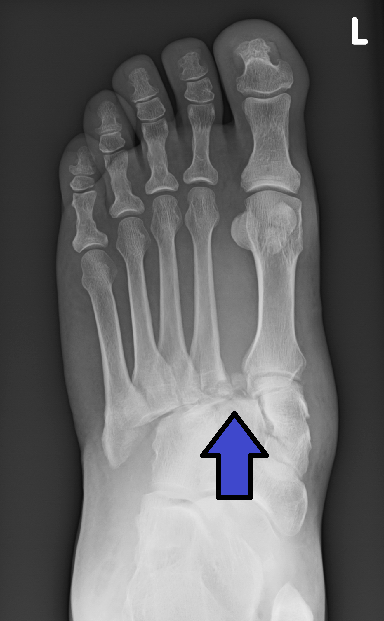What is the Lisfranc Ligament?
The lisfranc ligament complex stabilises the midfoot.
There is some anatomical variation, but typically the Lisfranc ligament extends obliquely from the lateral surface of the medial cuneiform to the medial aspect of the base of the second metatarsal and is comprised of three bands:
- dorsal ligament: weakest
- interosseous ligament ("Lisfranc ligament proper")
- plantar ligament: sends bundles to the second and third metatarsal bases (variable)
How do you injure the lisfranc ligament?
The Lisfranc ligament is most commonly injury during a rotation injury of the foot. This can occur in sports such as football or rugby, with the foot being caught under an athlete being tackled. Commonly the foot is in "toe off position," with the toes extended and the foot vertically orientated. It is famous for also occurring when a horse rider falls off a horse, but their foot remains caught in the stirrups.
How common are lisfranc Injuries?
Lisfranc injuries are relatively rare, occurring at an incidence of 1 per 55,000 population and comprising only 0.2% of all fracture injuries their incidence within certain sporting population is high, with study data recording up to 4% of collegiate American footballers (Robertson et al., 2019).
How are Lisfranc Injuries managed?
Lisfranc injuries can be managed conservatively with immobilisation and protected weightbearing. Alternatively, these injuries can be operatively repaired. This can occur in a two stage process with internal metal fixation, or with synthetic ligamentous threading.
How long does it take to return to sport following injury?
This will depend based on the severity, treatment option selected and sport. Athletes tend to return to sport at around the 6 month mark following injury with a recent systematic review finding return rates of 15-20 weeks (Robertson et al., 2019). A systematic review of athletes and military personal showed return times of low energy lisfranc injuries to be 58 days for nonoperative management, and 116 days for operative management (Khalil Attia at al., 2021). However, clinically, some athletes will struggle to return inside 12 months.
Robertson, G. A. J., Ang, K. K., Maffulli, N., Keenan, G., & Wood, A. M. (2019). Return to sport following Lisfranc injuries: A systematic review and meta-analysis. Foot and Ankle Surgery, 25(5), 654–664. https://doi.org/10.1016/j.fas.2018.07.008
Attia, A. K., Mahmoud, K., Alhammoud, A., d’Hooghe, P., & Farber, D. (2021). Return to Play After Low-Energy Lisfranc Injuries in High-Demand Individuals: A Systematic Review and Meta-Analysis of Athletes and Active Military Personnel. Orthopaedic Journal of Sports Medicine, 9(3), 2325967120988158–2325967120988158. https://doi.org/10.1177/2325967120988158


